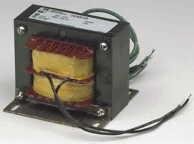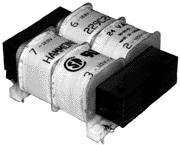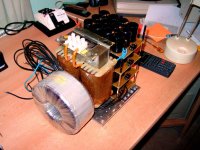Bifilar vs Dual split bobins
Grataku,
is it better to have one bifilar winding or two identical windings on two separated isolated (dual split)bobins for the secondary and also for the primary(four split) made on a single C-core trafo?For example if you want to create a CT,you connect them in series and you'll get two times less capacitance in either cases and of course two perfectly identical voltages out of the trafo,as you said, either you make them bifilar or on separated bobins.But which is better or it doesn't matter? AC coupling from the mains and all the junk will be much smaller in both cases due to the decreased capacitance.But what about the other parameters?Leakage inductance,smaller isolation in bifilar windings etc..etc.. Is it highly recomended making them split bobins or not,or it is better and more practical to go bifilar? Is any factory producing high wattage trafos in dual split bobins?Or with bifilar windings?
Regards,
Yugovitz
grataku said:If you are rewinding it is much better to do a bifilar-type or in your 8kw case quadrifilar, unless you have 8 gauge magnet wire laying around. That way you get two perfectly identical voltages out of the trafo. Keeping two secondaries separated by two fullwave bridges is much better than having a single CT/two rectifiers combination.
It is an undisputed electronics fact. There was a very good expl. on the forum by Fred, but that's ancient diyaudio.com hystory. See if you can find it with a search.
Grataku,
is it better to have one bifilar winding or two identical windings on two separated isolated (dual split)bobins for the secondary and also for the primary(four split) made on a single C-core trafo?For example if you want to create a CT,you connect them in series and you'll get two times less capacitance in either cases and of course two perfectly identical voltages out of the trafo,as you said, either you make them bifilar or on separated bobins.But which is better or it doesn't matter? AC coupling from the mains and all the junk will be much smaller in both cases due to the decreased capacitance.But what about the other parameters?Leakage inductance,smaller isolation in bifilar windings etc..etc.. Is it highly recomended making them split bobins or not,or it is better and more practical to go bifilar? Is any factory producing high wattage trafos in dual split bobins?Or with bifilar windings?
Regards,
Yugovitz
Byteboy,
it´s the unscreened version. The screen would make it too big to fit in the chassis. I called Tauscher and somehow after that I was convinced that the screening wasn´t so important in this case (can´t remember why though )
)
I will probably put a piece of copper sheet below the circuit board or below the second bank of caps if I have problems with noise/humm. The chokes are also a bit too close to the input for my liking but I will wait until I listen to it before doing anything. In my Aleph 5 the chokes and (unshielded) transformers are also very close to the circuit board and I´ve got no humm/noise to speak of, see the pictures in the following thread:
http://www.diyaudio.com/forums/showthread.php?threadid=3589&highlight=
I finished the second power supply and the "only" thing left to to is to match some fets and mount them on the heatsink plus the wiring between circuit board and output stages.
william
it´s the unscreened version. The screen would make it too big to fit in the chassis. I called Tauscher and somehow after that I was convinced that the screening wasn´t so important in this case (can´t remember why though
I will probably put a piece of copper sheet below the circuit board or below the second bank of caps if I have problems with noise/humm. The chokes are also a bit too close to the input for my liking but I will wait until I listen to it before doing anything. In my Aleph 5 the chokes and (unshielded) transformers are also very close to the circuit board and I´ve got no humm/noise to speak of, see the pictures in the following thread:
http://www.diyaudio.com/forums/showthread.php?threadid=3589&highlight=
I finished the second power supply and the "only" thing left to to is to match some fets and mount them on the heatsink plus the wiring between circuit board and output stages.
william
bifilar
You must mean 2 parallel or 4 parallel windings.A bifilar winding on a transformer gives you 0 Volts at the output.A bifilar winding is in principle 2 parallel windings with the end of both windings shorted at one end.Bifilar winding is used in wirewound resistors and is intended to prevent the winding from generating a magnetic field.(creating a coil).
You must mean 2 parallel or 4 parallel windings.A bifilar winding on a transformer gives you 0 Volts at the output.A bifilar winding is in principle 2 parallel windings with the end of both windings shorted at one end.Bifilar winding is used in wirewound resistors and is intended to prevent the winding from generating a magnetic field.(creating a coil).
Re: bifilar
Yes,you are right but can't you connect the start of the one winding with the end of the second one thus creating double voltage with centre tap?You can compare the same with two paralel windings(dual bobin) connected in series which will form double voltage with centre tap again.It is the same by the end result, but my question was if it is totally equal regarding all other parameters(capacitance,inductance etc....)!
Regards,
Yugovitz
kro5998 said:You must mean 2 parallel or 4 parallel windings.A bifilar winding on a transformer gives you 0 Volts at the output.A bifilar winding is in principle 2 parallel windings with the end of both windings shorted at one end.Bifilar winding is used in wirewound resistors and is intended to prevent the winding from generating a magnetic field.(creating a coil).
Yes,you are right but can't you connect the start of the one winding with the end of the second one thus creating double voltage with centre tap?You can compare the same with two paralel windings(dual bobin) connected in series which will form double voltage with centre tap again.It is the same by the end result, but my question was if it is totally equal regarding all other parameters(capacitance,inductance etc....)!
Regards,
Yugovitz
transformer winding
When you have 2 parallel windings the length of wire is exactly the same as will be the resistance,inductance and capacitance.You can't put a screen between these windings though.When you have one winding on top of the other the outer winding is longer which means more resistance,more capacitance and less inductance but you can put a screen between the two.I don't think it will make a lot of difference either way though.
When you have 2 parallel windings the length of wire is exactly the same as will be the resistance,inductance and capacitance.You can't put a screen between these windings though.When you have one winding on top of the other the outer winding is longer which means more resistance,more capacitance and less inductance but you can put a screen between the two.I don't think it will make a lot of difference either way though.
split bobbins
In power supply applications IMHO, I would prefer a split bobbin type of construction.
It results in good isolation of AC-line borne EMI because of practical no capacitive coupling between the primary and secondairy windings (they will likely be on oposite transformer legs with C-core)
In this way powerline static noise is prevented from traveling "trough" the transformer to the secondairy windings and connected audio electronics.
Also in case of multiple primairy and/or secondairy windings these would be aside, instead of on top of each other, thus also reducing the capacitive coupling between them.
I would value this, in this case, (much-) higher than optimum symetry in specs for dual windings as achieved by bifilar winding techniques, although I would agree that keeping them as equal as possible would be a good thing.
I think I read somewhere that the isolation achieved by the split bobbins technique is superior to the static screen approach, it also makes better use of the physical space available.
It was nice to see that a kind of "semi split bobin" technique is also used with some toroidial power transformer types from Tauscher. (website Tauscher, good reading on transformer technology!)
In the shown example each winding was wound on an isolated separate section of the torus, thus creating high isolation resistances between windings in a EHT transformer.
For DIY applications this will probably be too expensive though, I'm afraid......
In power supply applications IMHO, I would prefer a split bobbin type of construction.
It results in good isolation of AC-line borne EMI because of practical no capacitive coupling between the primary and secondairy windings (they will likely be on oposite transformer legs with C-core)
In this way powerline static noise is prevented from traveling "trough" the transformer to the secondairy windings and connected audio electronics.
Also in case of multiple primairy and/or secondairy windings these would be aside, instead of on top of each other, thus also reducing the capacitive coupling between them.
I would value this, in this case, (much-) higher than optimum symetry in specs for dual windings as achieved by bifilar winding techniques, although I would agree that keeping them as equal as possible would be a good thing.
I think I read somewhere that the isolation achieved by the split bobbins technique is superior to the static screen approach, it also makes better use of the physical space available.
It was nice to see that a kind of "semi split bobin" technique is also used with some toroidial power transformer types from Tauscher. (website Tauscher, good reading on transformer technology!)
In the shown example each winding was wound on an isolated separate section of the torus, thus creating high isolation resistances between windings in a EHT transformer.
For DIY applications this will probably be too expensive though, I'm afraid......
Bifilar vs Split windings
So the point was that splitting the secondary in two identical separated side by side windings is actually better than achieveing the same Vsec through the bifilar winding of the same secondary and having thus only one bobbin?Aside from the Prim/Sec isolation which is definitelly better with split bobins then with windings one up to the other.Any other more technical opinions?
Regards,
Yugovitz
So the point was that splitting the secondary in two identical separated side by side windings is actually better than achieveing the same Vsec through the bifilar winding of the same secondary and having thus only one bobbin?Aside from the Prim/Sec isolation which is definitelly better with split bobins then with windings one up to the other.Any other more technical opinions?
Regards,
Yugovitz
Attachments
- Status
- This old topic is closed. If you want to reopen this topic, contact a moderator using the "Report Post" button.
- Home
- Amplifiers
- Pass Labs
- Aleph-X power supply First tests


